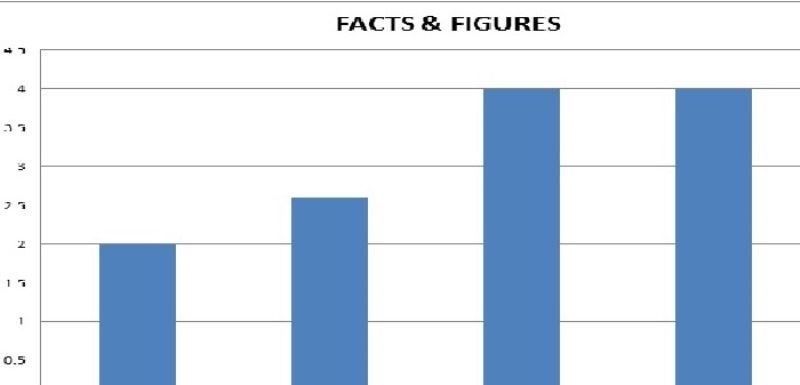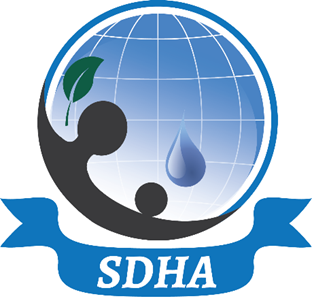
Since 2009, “approximately one person per second has been displaced by a [natural] disaster”, which leads to a total of nearly 23 million people displaced since 2008. The largest increases in displacement are related to floods and other weather-related disasters. Climate change is expected to exacerbate these issues. Additionally, 91% of global displacement happens in developing countries, and most displacement happens in middle income countries, which can partially be attributed to urban population growth increasing risk.
The number of natural disasters in Sub-Saharan Africa have been increasing since the 1970s, and they are detrimental to economic development and infrastructure development, which are both solutions to many other environmental problems. Displacement is a major problem in Ethiopia, South Sudan, and Sudan, which are all in the 20 most affected countries as of 2014. As a region, Sub-Saharan Africa has one of the lowest levels of displacement, with 1,000 people displaced per million during 2014. However, as populations continue to grow in Africa, more and more people will be exposed to environmental risks.
The primary natural disasters in Rwanda are floods and landslides, which undermine many development efforts. The increase in these disasters can be attributed to heavy rain, deforestation, climate change, and land use changes. The frequency of the events varies by region, which can be seen in the figure below. One of the best ways to predict the occurrence of a flood or landslide is to look at the location of past landslides, so identifying high-risk areas can limit the damage caused by natural disasters. Additionally, public education about natural disasters can also help reduces the numbers of deaths and injuries caused by natural disasters.
In this regards, therefore, SDHA proposes actions for preventions and management to increase the cooping power for the communities. Tangible actions to set forth are among others: Public awareness, capacity building for communities, setting up measures for emergency response in case of disasters. SDHA will keep working closely with the Government and other stakeholders on both concrete and policy action to enhance citizens coping power to disasters.
WATER POLLUTION
In developing countries worldwide, water pollution is increasing as urban populations grow. The main pollutants are pathogens, organic pollution, salinity pollution, and eutrophication. Around 1/3 of river ways in Latin America, Africa, and Asia are contaminated by pathogens, around 1/7 of river ways in Latin America, Africa, and Asia are contaminated by organic material, and around 1/10 of river ways in Latin America, Africa, and Asia are contaminated by high salinity levels. All of the mentioned pollution levels were measured at a moderate to severe level, meaning these statistics show that the majority of river ways on these continents still have only mild levels of pollution.
One major water quality issue in Sub-Saharan Africa is availability and standardization of water testing. A study by the Aquaya Institute analyzed 42,926 water quality tests that measured microbial water quality. The study showed that fecal indicating bacteria (FIB) was detected less when the samples were collected from water piped to plots and public standpipes. It also showed that water from protected springs and wells, which are considered improved water sources, had high levels of contamination compared to other types of improved water sources. In fact, protected wells had similar levels of contamination to other unimproved sources. The study also found that the greatest proportion of contaminated samples came from unimproved sources religious institutions, camps for workers and refugees, and houses. Though the quality of piped water systems is acceptable on average, access to these systems is still low in the region.
In Rwanda, the water quality varies within the country. The National University of Rwanda analyzed many facets of water quality at sites in the Congo River Basin and Nile River Basin. They found that the vast majority of the sites in both areas had turbidity levels above the standard. Turbidity varies by season, and high turbidity can increase pollution. The majority of the sites also have high of suspended solids, which come from human activity or erosion. Lastly, fecal coliforms, E.coli, ammonia, and iron are all found in concentrations higher than the standard nationwide. Some of these results can be seen in the figures below.
FOOD SECURITY AND NUTRITION
The Global Food Security Index (GFSI) is a value that considers the affordability, availability, and quality of food. For 2016, the highest GFSI was 86.6, while the lowest was 24.0. Over 75% of the world’s countries have had increasing GFSIs since 2011, this is largely due to growing economies. Some factors that currently inhibit and may inhibit future growth are political instability, weather and climate related risks, governmental policies that interrupt the market, and lack of infrastructure.
In Sub-Saharan Africa, the prevalence of malnourishment in the region decreased by 31% from 1990 to 2015. However, the nourishment of the population varies across the region, and there is still much to be improved upon. Rapid population growth currently prevents countries in the region from supplying an adequate amount of food. Additionally, political conflict, limited use of agricultural management practices, and low levels of infrastructure inhibit food security in the region.
In Rwanda, food is generally available, and 80% of households are food secure, though about half of those households are at risk for becoming food insecure. Food insecurity is highest in the western and northern regions of the country, though 50% of households throughout the country cite food access issues. These access issues usually occur seasonally. Malnutrition still remains high in Rwanda, especially malnutrition of children. 38% of children under age 5 are malnourished. Malnourishment can lead to many health issues such as stunting, anemia, and intestinal worms. In general, levels of food security and nutrition have shown improvement.
CLIMATE CHANGE
Recently the world has started to come together around the issue of climate change. Climate change will have widespread effects, including changing many environmental determinants of health. In general, climate change will cause an increase in respiratory disease due to increased temperatures which increase the concentration of pollutants. Additionally, an increase in flooding can contaminate water sources leading to an increase in water-borne diseases. The World Health Organization predicts that by 2030, there will be 241,000 additional deaths due to climate change. The most vulnerable populations will be those living in island states, coastal regions, megacities and polar regions.
In Sub-Saharan Africa, the effects of climate change are already being seen in increasing aridity and changes in rainfall patterns. This impacts the region’s water security, as climate change also contributes to a higher demand for irrigation water and groundwater contamination. This variability in water quantity and quality is especially detrimental because Sub-Saharan Africa is so dependent on agriculture. In the worst-case projections by the IPCC predict that there will be 27-32% losses for maize, sorghum, millet, and groundnut for a warming of 2 °C. This will affect human health by changing the affordability of food, which, in turn, would increase undernutrition in the region. Flooding, which is expected to increase due to climate change, can also lead to an increase of transmittable diseases. In the case of a 4 °C temperature change, flooding is projected to affect approximately 5 million people assuming a lack of population adaptation. In the same vein, climate change is expected to continue to displace people and in Sub-Saharan Africa, this much of the resulting migration is from rural to urban areas. Urbanization is associated with risks such as political conflict and the increase of disease.
In Rwanda, average rainfall and intensification of heavy rainfall is predicted to increase due to climate change. This means more rainfall will occur during a few large storms, leading to flooding. This flooding will lead to many of the effects discussed above, including damage to infrastructure, higher human mortality rates, and water contamination. An increase in malaria due to environmental changes can already be seen in the Rwandan highlands, an area which was previously unaffected. Continuing changes in climate can also lead to regional malnutrition, an increase in respiratory diseases, and many other public health issues.
ACCESS TO CLEAN WATER AND SANITATION
In 2010, the United Nations (UN) formally recognized the human right to water and sanitation. This recognition acknowledges the fact that clean water and sanitation is critical to the fulfillment all human rights. This is reflected in the UN’s Millennium Development Goals (MDGs), which are development goals related to health, education, and sustainability to be met in 2015. As of 2015, 91% of the world population has access to clean water and 68% have access to improved sanitation. Though the level of water access meets the MDG, the level of sanitation falls short. Additionally, regardless of MDG status, 663 million people still lack access to clean water and 2.4 billion people lack access to improved sanitation.
Within sub-Saharan Africa, the access to clean water and improved sanitation is below average. 68% of the population is sub-Saharan Africa has access to clean water while only 30% of the population has access to improved sanitation. This can be seen in Figures 1 and 2 which show the population without access to improved sources of drinking water and improved sanitation facilities, respectively.
In Rwanda specifically, 76% of the population is estimated to have access to improved sources of water. This below the global average but above the average for Sub-Saharan Africa. The head of UNICEF’s water and sanitation program cites a lack of behavior change as the problem, an issue many NGOs are trying to address
